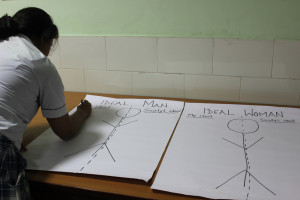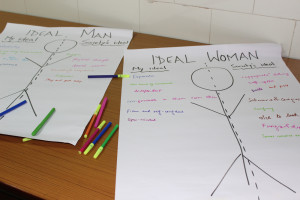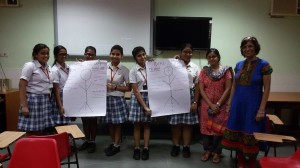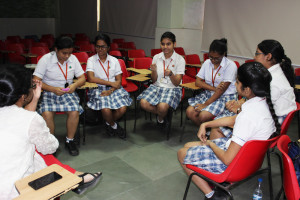As Martin Scorsese once said, ‘Cinema is a matter of what’s in the frame and what’s out’. Movies are an important part of an audio-visual experience and education. They are full of impact and stir emotions unlike some textbooks, which fail to do so. PeaceWorks takes pride in the fact that it has amassed a plethora of movies over the years, including documentaries, regional movies, animated movies, and other non-mainstream cinema as a source of education.
The PeaceWorks Film Programme was part of a two-day film festival on 16 and 17 June, 2016, for senior school students at Mahadevi Birla World Academy, Calcutta.
One of the most controversial Indian documentaries was screened on the first day as a part of the film festival—Anand Patwardhan’s ‘Father, Son and the Holy War’ had created a furore during the time of its release. It views the harsh reality of communal tension in India since independence. The subtle hints of sexism and defined gender roles throughout the movie were an eye-opener for the students along with images of victims of communal riots juxtaposed with images and interviews with superstitious Indians, who chose to be blind to the injustice.
After the screening two charts, with simple, gender unidentified stick figures drawn on them were circulated among the students. One was marked as ‘Ideal Man’ and another as ‘Ideal Woman’, both having sub-headings of ‘My Ideal’ and ‘Society’s Ideal’. The students soon filled out the papers and surprisingly both the columns of ‘My views’ turned out to be very similar to each other, implying that there is not much difference as to what is expected from an ideal man and woman. The only area of difference was seen while the students filled up the columns of ‘Society’s views’, implying that society is to blame while defining gender roles and stereotypes. However, by the end of the day, who is society but us, the people?
Exploring ideas beyond the central theme of the movie, the students raised points on gender stereotypes and the gender roles defined for the society by society. They talked about the ‘naturalisation’ of certain activities in the society like bad-mouthing another community, leading to certain preconceived notions, thereby making it a part of everyday life. Strength is always measured by the physical abilities of a person and ‘Macho’ is used to define men who are perceived as being ‘stronger’ in the society while women become the ‘weaker’ sex, since she wears a saree. Even the so-called educated Indians, as shown in the movie are victims of superstitions, carried away by the prospect of bearing a son.
‘I feel that one of the major reasons for the aggravation of communal hatred is the media’, said a student. She went on to explain how the press and media have played damaging roles in disguise, to widen the gap between the communities as well as the sexes in India.
‘It was disturbing, depressing and an eye-opener. I could not help but get ‘pissed off’ by such a scenario, which our society harvests’.
When asked what they felt about the term ‘feminism’, most said that while they considered themselves feminists, there were certain restrictions preventing them from being, if one can call it that—fully feminist. They spoke about how they could equate feminism with freedom. ‘Travelling by yourself on the streets of Kolkata feels like liberation’, said two of the students.
‘Turtles Can Fly’, a critically acclaimed movie was screened as a part of the festival on the second day. It is a Kurdish movie, directed by Bahman Ghobadi, which was the first film made in Iraq after the fall of Saddam Hussein. After the movie ended, an aura of discomfort was sensed among the audience. They were aghast at the message the movie had to provide. Once the discussion started with the students and teachers, they had many insights on the movie, leading to discussion on topics like crisis, corruption, violence and the human condition during wars. The notion of ‘morality’ came into picture and everyone agreed that human beings are unable to hold onto their morals, when pushed to the brink—for example in the case of war. The gloom that engulfed the visages of the students, made it clear how great an impact the movie made. Some were in tears while others were seething in anger.
‘The movie made me think of someone else’s point of view.’ said one of the students during the discussion. She explained that while what happened in the film was unfathomable, it was impossible to ‘judge’ a person unless one completely understood the situation the person was in.
Taking the discussion forward, one of the teachers, mentioned that war, as depicted in the film, was a realistic one, as opposed to the wars shown on news channels. Increasingly, the media is playing a role in de-sensitizing the larger community, by showing them cases of human rights violations (as in war), almost immediately juxtaposed with images of ‘celebrities’ at say, movie awards nights.
‘It (the US- Iraq war) was a video-game war and this war meant good business. People watched from homes, relaxed on cushions, said one of the teachers who attended the screening.
When are we giving ourselves and others the time to internalize and process what is happening in the world? Are we being open enough, to address our emotions and in fact, to be emotional? Or have we just become an uniform mass of cynicism?
The role of cinema needs to be reexamined and given the due importance of being an agent of change.
– Shreyashee Roy
Intern




